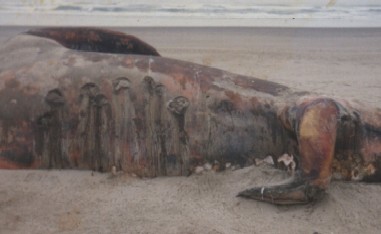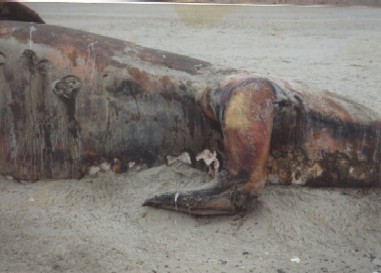Mystery Photos: Sea Serpent or Plesiosaur? Name That Carcass! More to Chew On!
Posted by: Craig Woolheater on February 3rd, 2006
Michael Cenedella, the gentleman who took the photos of whatever this carcass is, was kind enough to email me some additional photos of the carcass.
As the circular marks on the carcass are a hot topic of discussion on the original blog entry with the photos, I figured that I would share these photos that show more detail of the marks.
They had been described variously as teeth marks from lampreys, cookie cutter or white sharks, to marks left by someone kicking the carcass. I don’t know why you would want to kick a rotting carcass, but I guess that’s a possibility.
If you had heard the story from one of my co-workers regarding a canoe trip on a river here in Texas, I bet you wouldn’t kick a rotting, beached carcass. To sum up the story, the moral to it was, do NOT, under any circumstances, decide that it would be a good idea to use a canoe paddle to wail on a bloated cow carcass that has wedged itself up against a bridge pillar in the river. Suffice to say, you have never smelled anything quite like the gaseous anomaly that would be emitted from said carcass. So, in summation, kicking the carcass would be "not good."
Maybe with the additional detail, someone may be able to identify the cause of the marks.
Click photo above to view full-size
Click photo above to view full-size
Photos copyright Michael Cenedella and are posted with his written consent. Mr. Cenedella upon research, believes the beastie to be a gray whale.
About Craig Woolheater
Co-founder of Cryptomundo in 2005.
I have appeared in or contributed to the following TV programs, documentaries and films:
OLN's Mysterious Encounters: "Caddo Critter", Southern Fried Bigfoot, Travel Channel's Weird Travels: "Bigfoot", History Channel's MonsterQuest: "Swamp Stalker", The Wild Man of the Navidad, Destination America's Monsters and Mysteries in America: Texas Terror - Lake Worth Monster, Animal Planet's Finding Bigfoot: Return to Boggy Creek and Beast of the Bayou.











Gee kids- I don’t want to make anyone feel stupid… but here goes.
The carcass is obviously some sort of baleen whale.
The ‘mystery appendage’ is the whale’s penis.
The ‘strange’ circular marks are probably scars from squid or parasites or postmortum bird feeding.
Giant squid suckermarks?
I’m a marine biologist, and that’s a photo of a whale penis. The lesions look like circular welts made by squid. The photos in the original post look a bit more plesiosaur-like – but it’s still a whale.
Hi. I’m Mike Cenedella, the guy who took the photos. So here’s the skinny. First, I didn’t recall the date exactly, so I had some vagueness. Sometimes I’d think 90, or 91, or 92. Joanne and I dated for a while. I’ve had the photos all these years. I should have put a backpack next to it. It didn’t stink at all, surprisingly. It looked very different from whale carcases I’ve seen on the Washington Coast, some of which stunk for sure!
After I put up the website (spurred on by the National Geographic article), I called the Hatfield Marine Science Center in Newport, OR. The first researcher who saw the pics said, “Oh, Wow. There’s no fluke.” She passed the pics to a more experienced reasearcher who said it was probably a gray, possibly a humpback. He said he’d seen many dead whales, kept the database of strandings, and had seen many dead whales.
He figured it had died at sea (Didn’t specify how, so I can’t comment on the suggestions here that it starved or was strangled.) He figured it was dead about three weeks before being rolled ashore. Said the flukes commonly fall off and that the head can deteriorate quite a bit. He also said he’d seen many whale penises that looked like that. So, lucky me, I spoke with an expert on decomposing whale penises.
He checked the database and found an entry for a gray on Cape Meares (our location) in 1992. So I regard that as the solution, darn it.
I wish I’d had a shovel; I would have dug. We didn’t touch it.
The whole thing is interesting because it LOOKS so much like something else. I’ll track down the emails I exchanged with the researcher, put them, the photos, nautical charts and maps in a zip and put it somewhere where you can ftp it.
Mike
Actually, I believe that the marks are the exact size and shape of the end of a ten-foot pole.
I am forced to agree with Nerull in that it is a dead whale.
Nope…. I’m afraid the whale penis theory still isn’t quite right. Based on these photos, I can see that this is actually the beastie’s back, and I don’t know any male whales with penises on the sides, much less on the back. The appendage is NOT on the center line, but twisted, possibly by a giant squid but a more likely culprit is a shark. If Mr. Cenedella had dug beneath the sand, he would have found a more complete appendage that faced the other direction. The body ends shortly after the back limbs, and the tail is wide enough to have been used in swimming. This is a dead pliosaur, it did die at sea, was about 40 feet long in life, and was more closely related to Kronosaurus than to Liopleurodon.
CryptoInformant, may I ask why you always seem to put forth the least likely “solution” when mystery creatures are discussed here? I’m not trying to start an argument here, but don’t you think it’s far more likely that this is simply a dead whale? Why make the leap that it HAS to be something that has allegedly been extinct for so long?
Long dead, and frozen in Icebergs, these could be floaters from eons ago, freed by the Warming waters. This could explain the weird, fast stenchfree decay. Also why eels took bites and left it alone. No whale penis has a knee and ankle. But, whales do have vestigial appendages (Feet) back there. Whale or Pleo, its an old and well aged slab of sea meat.
“Craig Woolheater Says:
Actually, I believe that the marks are the exact size and shape of the end of a ten-foot pole”
Now thats funny
jjames1-
I see the point to your comment, and I agree it could be a whale, but that limb is not a penis, but a probably vestigial back flipper. Upon a closer look at the photos, a pliosaur is still possible, but new, primitive species of whale IS more likely. What is not even a possibility is the recently thawed floater theory, as this creature was definitely breathing in 1991, and, may I ask, how would a PREHISTORIC ICEBERG get to Oregon, without thawing and having its long-dead contents float for a few weeks and then SINK?
Craig Woolheater-
What kind of IDIOT would be out there poking this thing, with anything less than 20 feet long?
The creature still was at least 40 feet while living.
The creature, dead whale or pliosaur, was at least 40 feet long in life. A whale is likely, but there are several lines of evidence that lead me to the pliosaur conclusion, I do NOT suddenly make the lead to long extinct animals.
Here are the features that point to a pliosaur.
-The back limb, no modern whale has that
-The apparent damage to that limb, it probably had more to it in life
-The thick neck, or what’s left of it
-The flipper, I’m not sure, but it looks a bit different from a whale’s.
-The barrel shaped body, whales’ bodies are more of just a continuation of the line of the tail
-The tall, narrow tail, or at least what we can see of it, whales have more circular tails.
Honestly.
Look up “whale penis” on Google Image search, ignore 60% of the results (unless you’re looking for a Valentine’s alternative to a ten foot pole) and have a good long look at whale penises. There’s variety, but many of them look very similar to the ‘appendage’ on the carcass.
Or just look here.
There is no reason to suppose that the carcass’ ‘leg’ lies on the dorsal surface. It DOES appear to follow a median line from tail to throat. That is not a limb, vestigial or otherwise.
Of course, relic populations of undiscovered ancient whales may have similar organs.. This doesn’t mean that the other unusual features should be dismissed out of hand – but I think this talk of ‘knees’ and ‘ankles’ is silly.
And thanks to Mr Cenedella for his detailed write-up.
Some kind of whale seems the most likely to me.
One question, though. Someone has theorized that marks on the carcass are sucker marks from a giant squid. I thought sperm whales were the only whales that tangled with giant squid because they hunt them. Do any other kinds of whales ever tangle with giant squid? If someone’s claiming that, what evidence do they present?
No, no others tangle with the giant squid. Because of Mr. Cenedella’s comments about the nice, fresh, rot-free smell, I would say the creature actually hadn’t been dead very long. It could have died not too far off shore, and washed up overnight. The whale penis still doesn’t fit, because you can see the shape of muscles and bone. The curve in it fits the basic bite shape for a Great White Shark, which always attacks from below, suggesting that the shark was only testing for edibility, and slammed into the flipper, breaking it to where it rests nearly on the back and rips off a chunk with enough force to decapitate a seal.
Could be a primitive whale, a pliosaur, however, just appears more plausible except for the 65 million years of extinction. (Anyone say Coelacanth?)
Although i would love for this to be a extinct species i do think that it is a whale carcass that washed ashore.
Based on all the photos, I have done a drawing that shows both sides of the creature, and it turns out that the side withe the appendage is the VENTRAL surface, or the belly of the beastie, and the appendage itself is definitely not whole, but a damaged flipper attached to a ball-and-socket hip joint.
If it is a whale, which is very possible, then it is primitive. If it is a pliosaur, then, like the ceolocanth, it seems to have missed an important memo.
I will e-mail in the drawing as soon as possible.
Any guesses on what memo it missed, but T-Rex, Trilobites, and sea scorpions got?
I don’t know how to upload pictures yet, but should figure out soon.
Cryptoinformant,
If you’ll email me your drawing, I’ll evaluate it and see if I’d like to add it to my site. [email protected].
Mike
Well, first I have to find my digital camera and upload it to my computer, but sure.
D’oh! Well now that I look at it closer, this just doesn’t look right for a pliosaur. It all points to either a mosasaur or primitive whale. The rear limb is, either way, vestigial. The roughly circular marks, based on a discussion here at the still small SCCZ, appear to be about a foot in diameter, and a lamprey would have to be freakishly large, (on the order of up to 12 feet), to do that, so we settled on a cookie-cutter shark, which is still unusually large, (up to twice its usual size, at 1+1/2 feet), but far more plausible.
attempted to upload drawings, failed. Redrawing and trying again. (good grief, you’d think I’d have more time on my hands.)
it’s a whale that has been attacked by a sea serpent……simple as a pie….